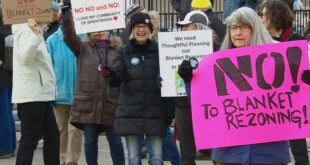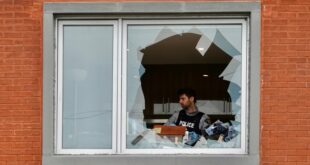146 boarded-up properties in North Central, 41 in Heritage as of April, city says.

A bungalow sits on the corner of Seventh Avenue and Retallack Street in Regina’s North Central neighbourhood. Plywood covers most of its windows. The mudroom roof is starting to cave in. The grass is unkempt, with two thin trees growing up from under the front steps.
Ward 3 Coun. Andrew Stevens participated in a ride-along through his jurisdiction with members of the City of Regina’s bylaw enforcement department last month. The officers brought him to this house.
“I asked [bylaw] what would be the best property to stand in front of, and they showcased this one,” Stevens told CBC News during an interview outside the house.
“This house and many others might have been a nuisance for the community by every measure for months or years. Sadly, we’re at a point where people would rather see houses demolished than have them turn into blight and nuisance properties that negatively affect the entire block.”
The city’s community standards bylaw lays out rules around how property owners must maintain their land and tenements, to create safe and attractive neighbourhoods. The bylaw tackles overgrown grass, placarded buildings and junked vehicles — among other things — and penalizes those who don’t abide by those standards.
Derelict properties, referred to in the bylaw as nuisances, are an ongoing issue.

Experts say these properties, which in Regina are disproportionately located in neighbourhoods like North Central and Heritage, create unsafe environments and bring down property values. Residents, meanwhile, feel neglected and believe these properties perpetuate stigmas about their neighbourhoods.
The city has made strides in recent years toward giving bylaw enforcement greater sway and demolishing such properties.
But getting rid of these properties — and replacing them — is easier said than done.
Nuisances in the neighbourhood
Leah O’Malley and two other volunteers walked their weekly beat on a rainy Friday evening, picking up needles in back alleys in the city’s north end and offering sandwiches, snacks and ponchos to people on the street who need them.
The trio passes multiple boarded-up, burned and abandoned buildings on their route. This time, O’Malley noted one that appeared newly occupied.
“This community has a problem with abandoned houses,” said O’Malley, board chair of White Pony Lodge, a non-profit based in the neighbourhood.

As of April, there were 146 boarded-up properties in North Central and 41 in Heritage, according to Desirae Bernreuther, a spokesperson with the City of Regina. In June 2022, there were 169 boarded-up properties in North Central and 39 in Heritage, Bernreuther said.
The community standards bylaw defines a nuisance as a “property, structure, thing or activity” that may or does negatively affect the “safety, health or welfare” of the neighbourhood or its residents.
Buildings that have been placarded for more than 90 days, or unoccupied buildings with doors or windows in disrepair, are among the properties considered nuisances.
O’Malley and other residents, however, have noticed multiple nuisance properties that have remained in their state for months, if not over a year.

Nobody from bylaw enforcement was made available for an interview, but Bernreuther told CBC News “a number of reasons” could lead to a property remaining in its state for longer than 90 days, such as the property owner waiting for insurance after a fire, a new renter, or it being completely abandoned.
The city tries working with landowners to figure out the situation and, “wherever possible,” get them to voluntarily bring their property into compliance with the bylaw, Bernreuther said.
If a building is damaged by fire, the Regina Fire Department boards up the structure and preserves the scene until its investigation is over. After that, it’s the owner’s responsibility again, Bernreuther said.
The timeframe for the work to be completed depends on various factors, such as the time of year and availability of materials and contractors, she said.

In the meantime, residents and other landowners have to bear the consequences.
“When you get an empty house, and if it sits empty for a long time, that puts stress on all the neighbours,” O’Malley said.
“Everybody else who’s living there, you kind of have to watch out for it, because nobody wants that to be broken into.”
People interviewed by CBC News say some intruders break into the properties for shelter, which invites the possibility of fires, as well as drug use. Others break in to steal things like copper wiring, which could lead to an explosion.
Each interviewee acknowledged the break-ins are symptoms of larger underlying social issues, namely poverty and homelessness.
The Regina Police Service has raised the issue within the past couple of years. In May 2021, the police presented a report to the city’s executive committee recommending more responsibility and stronger bylaw enforcement.
The recommendations, in part, aim to minimize the risk of recurring issues such as squatting and fires, according to an executive committee report from last year. The committee passed the item, which proposed stiffer fines for property owners whose structures become unsecured and whose properties don’t comply with the community standards bylaw, among other things.
The hazards that tend to come with derelict properties create “a perfect storm of danger” that drops the value of neighbouring properties, said Cameron Choquette, CEO of the Saskatchewan Landlord Association.
In places like North Central, which has a lot of rental housing, that affects landlords particularly.
“It’s a year-round issue,” Choquette said. “We want to level up the standard of housing in Regina — and across the province. We want to make sure our communities are safe, as free from crime as they can be, and aren’t filled with eye-soring, boarded-up properties that attract crime and vagrancy.”
He urged all of his association’s membership, rental providers and homeowners to follow the bylaw.

Stigma and neglect
Erinn Brouzes and her fiancé, who grew up in North Central, recently took a day off from work to drive around the neighbourhood, from Fourth to Ninth avenues and Elphinstone to Argyle streets.
They jotted down the address of each nuisance property and vacant lot, noting whether people were occupying the property at the time. Later, they searched the names of each respective property owner, creating a database of the 98 properties they found.
CBC News obtained a copy of their spreadsheet. Many of the properties neighbour each other. A couple streets have more than 20 properties on the list.
“It’s completely unacceptable that any neighbourhood in any city would have this many [derelict] homes,” said Brouzes, whose family moved to North Central several months ago from Cathedral.
“You would never see anything like that in the Cathedral neighbourhood — and it’s the same ward.”
Brouzes grew up in Winnipeg’s North End, considered the roughest part of Manitoba’s capital city, but said she only remembers the strong sense of community there.

She sees a lot of similarities in North Central, but said derelict properties are worsening the stigma.
O’Malley, from White Pony Lodge, has lived in the neighbourhood for 16 years. Despite its reputation as a dangerous place, she feels safe because there are people around and she knows her neighbours.
“It’s disheartening,” O’Malley said.
“People who live in this neighbourhood, who already feel disenfranchised, that is going to make you feel even more disenfranchised when your neighbourhood is abandoned like that.”
Brouzes has chatted with her neighbours about the derelict properties, as well as other civic issues. She said they encourage her and her fiancé to keep fighting, because they’re tired of trying.
“They feel as though they’re just being neglected,” she said.

Remedy for nuisance properties
The city can step in to bring a property in line with the standard, Bernreuther said, but will only do so once “all efforts to achieve voluntary compliance have failed.”
In such a case, the city will do the work and apply it to the property owner’s taxes. Usually, the city sends a contractor to do the repairs, Bernreuther said.
The last resort is demolition. Bylaw enforcement demolished 22 properties last year, including 15 in North Central, Bernreuther said.
Seven properties have been demolished so far this year, she said. Three more are in progress and five others are in the queue.
Coun. Stevens told CBC News there has been significant progress on getting rid of these properties within the past few years, partially due to new leadership and more co-ordination among bylaw enforcement and other departments.
“Everybody has now started to take this matter seriously,” he said.
“We’ve seen more action in terms of securing properties, holding property owners to account, as well as demolitions than we had, arguably, in the last 10 years.”

But demolishing buildings gets complicated.
The city has to consider multiple factors, such as how often a property has been boarded up and whether bylaw enforcement is certain nobody lives in it, before issuing an order to comply to the property owner, Bernreuther said. Once that is issued, the property owner can appeal the decision within 15 days.
If they do not appeal, the city sends a contractor to the property, Bernreuther said. But oftentimes, depending on the age of the building, asbestos testing is needed. If tests are positive, the asbestos must be removed before demolition.
Then, after a building is torn down, the question of what happens to the land remains.
There used to be several buildings next to the derelict property at Seventh Avenue and Retallack. Now there is nothing but a green, vacant lot.
The parcels of land are still privately owned, Stevens said, and nothing has replaced the dwellings that were once there.
“The conversation now is: what do we do with this?” he said.

Stevens said some local business owners and landlords hired a consultancy group to draft a document titled the North Central Revitalization Action Plan. Stevens handed that over to the city manager and staff, and said he’s waiting to see movement on it.
O’Malley suggests the solution in North Central is not more low-income housing.
“The low-income housing that we already have here, a lot of it is empty,” she said.
ABOUT THE AUTHOR
Nicholas Frew is a CBC Saskatchewan reporter based in Regina, who specializes in producing data-driven stories. Hailing from Newfoundland and Labrador, Frew moved to Halifax to attend journalism school. He has previously worked for CBC newsrooms in Manitoba and Alberta. Before joining CBC, he interned at the Winnipeg Free Press. You can reach him at nick.frew@cbc.ca.
*****
Credit belongs to : www.cbc.ca
 Atin Ito First Filipino Community Newspaper in Ontario
Atin Ito First Filipino Community Newspaper in Ontario






